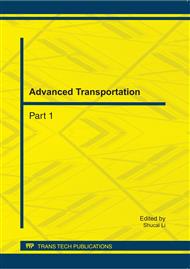p.78
p.85
p.91
p.95
p.100
p.108
p.114
p.121
p.130
Design Optimization and Safety Evaluation of Cross-Sea Bridge Barrier
Abstract:
By comprehensive analysis and design optimization of barrier structure parameters, a new type of beam-and-post steel barrier was invented according to impact test condition and acceptance criteria of cross-sea bridge barrier. Full-scale impact tests and finite elements analysis were conducted to do safty evalution of the barrier. The results show that, ASI value is 1.62 for test and that is 1.67 for FEA, THIV is 30.7km/h for test and that is 31.2km/h for FEA. Working width is 0.88m for test and that is 0.62m for FEA. Occupant risk evaluation index can meet the requirements of level B and the working width can meet the requirements of level W3. Both of tracking and posture of vehicles are well. The study results above show that safety performance of cross-sea bridge barrier can meet or exceed the acceptance criteria. FEA results are consistent with Full-scale impact test, which validate the reliability of FEA. cross-sea bridge barrier can meet the highest test level for beam-and-post steel barrier, which can defend the out-of-control vehicles effectively and help to ensure the bridge safety.
Info:
Periodical:
Pages:
100-107
Citation:
Online since:
September 2011
Authors:
Price:
Сopyright:
© 2011 Trans Tech Publications Ltd. All Rights Reserved
Share:
Citation:


